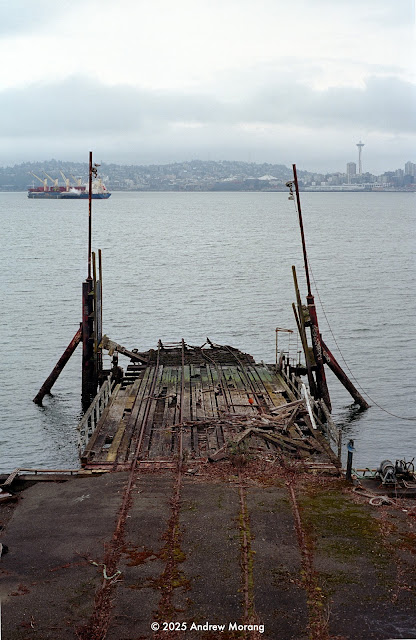Western Washington was once criss-crossed by hundreds of miles of rail lines. Many mountain valleys had regular or narrow gauge lines to serve the lumber industry. Many of them were abandoned in the 1970s as the lumber industry wound down, but some remnants remain. BNSF (Burlington Northern Santa Fe) operates its main line from Longview, on the Colombia River, north to Vader, Chehalis, Centralia, Tenino, East Olympia, and then on to Tacoma. This carries mostly cargo, but Amtrak uses the tracks for its passenger service.
Olympia was once served by two railroads, the Northern Pacific and the Union Pacific. The tracks still exist, and Olympia & Belmore Railroad, Inc., operates the occasional freight cars. I sometimes hear a locomotive horn but have never see a train trundling down Jefferson Street. Amtrak's station is on the Yelm Highway in Lacey, the town southeast of Olympia. The Amtrak does not go into downtown Olympia.
7th Avenue Tunnel
 |
| The "Subway" (Fuji Acros film, Leica M2, 90mm ƒ/4 Elmar lens) |
When the Northern Pacific first brought service into downtown Olympia in 1891, the tracks came down the Deschutes River valley, past the brewery complex, and along the tide flats. The track turned east and went through a tunnel to emerge near Jefferson Street. It is ugly and dirty now. A homeless man was badly injured in the tunnel years ago.
Jefferson Street
 |
| Jefferson Street view north. Where is the train? (Fuji Acros film, Pentax Spotmatic F camera, 55mm ƒ/1.8 SMC Takumar lens) |
 |
| Jefferson Street view north |
 |
| Steps on Jefferson Street (55mm ƒ/1.8 SMC Takumar lens) |
The track in the foreground emerges from the subway (to the right out of the picture).
 |
| Jefferson Street view south |
 |
| View north from Olympia Avenue NE (Kodak T400CN film, Leica IIIC camera, 5 cm ƒ/2 Summitar lens) |
Rainbow Rails
 |
| Rainbow Rails view north (not very colorful any more; Kodak Tri-X, 100mm ƒ/3.5 lens) |
 |
| Rainbow Rails with State Capitol in the distance and 4th Avenue bridge (Kodak Tri-X, Hasselblad, 100mm ƒ/3.5 lens) |
 |
| Rainbow rails, view north, with West Bay to the right |
The Rainbow Rails ran along West Bay to a wood processing facility a short distance south of Tugboat Annie's restaurant. The name came from the colorful paint that artists painted on the ties near the 4th Avenue bridge. Much of the paint has faded, so you do not see much rainbow any more. The track is a somewhat difficult walk, but you are next to West Bay and can sometimes see a freighter across the water at the Port of Olympia. Water birds occupy a pond just to the west.
Port of Olympia
 |
| View south from Market Street NE (adjacent to the Olympia Farmers' Market) |
This track comes in from the south along Jefferson Street (see above). It diverges, and two lines enter the port area (off-limits to visitors). Most of the timber now comes to the port by truck, but I hear an occasional train, usually at night.
This ends our short railroad tour of Olympia. Later, I will post some pictures of the rail line near the unused Olympia Brewery complex in Tumwater. Thank you for riding along.























































